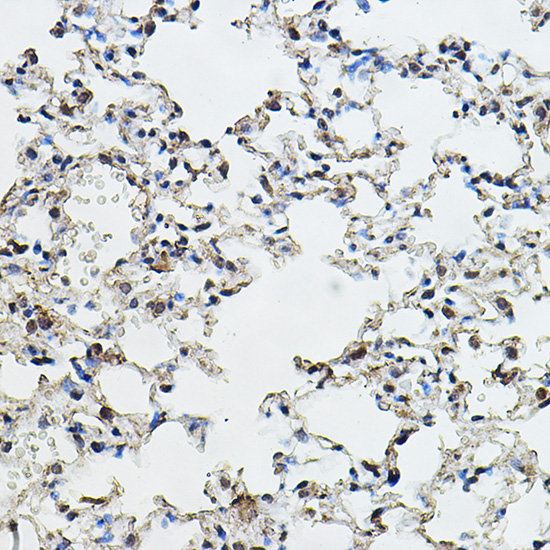Cell Cycle Antibodies 1
Anti-Cyclin E1 Antibody (CAB14225)
- SKU:
- CAB14225
- Product Type:
- Antibody
- Reactivity:
- Human
- Reactivity:
- Mouse
- Reactivity:
- Rat
- Host Species:
- Rabbit
- Isotype:
- IgG
- Antibody Type:
- Polyclonal Antibody
- Research Area:
- Cell Cycle
Description
| Antibody Name: | Anti-Cyclin E1 Antibody |
| Antibody SKU: | CAB14225 |
| Antibody Size: | 20uL, 50uL, 100uL |
| Application: | WB IHC |
| Reactivity: | Human, Mouse, Rat |
| Host Species: | Rabbit |
| Immunogen: | Recombinant fusion protein containing a sequence corresponding to amino acids 300-410 of human Cyclin E1 (NP_001229.1). |
| Application: | WB IHC |
| Recommended Dilution: | WB 1:500 - 1:2000 IHC 1:50 - 1:200 |
| Reactivity: | Human, Mouse, Rat |
| Positive Samples: | MCF7, K-562, Mouse brain, Rat brain |
| Immunogen: | Recombinant fusion protein containing a sequence corresponding to amino acids 300-410 of human Cyclin E1 (NP_001229.1). |
| Purification Method: | Affinity purification |
| Storage Buffer: | Store at -20'C. Avoid freeze / thaw cycles. Buffer: PBS with 0.02% sodium azide, 50% glycerol, pH7.3. |
| Isotype: | IgG |
| Sequence: | AASA LYHF SSSE LMQK VSGY QWCD IENC VKWM VPFA MVIR ETGS SKLK HFRG VADE DAHN IQTH RDSL DLLD KARA KKAM LSEQ NRAS PLPS GLLT PPQS GKKQ SSGP EMA |
| Gene ID: | 898 |
| Uniprot: | P24864 |
| Cellular Location: | Nucleus |
| Calculated MW: | 47kDa |
| Observed MW: | 47KDa |
| Synonyms: | CCNE1, CCNE, pCCNE1, cyclin E1 |
| Background: | The protein encoded by this gene belongs to the highly conserved cyclin family, whose members are characterized by a dramatic periodicity in protein abundance through the cell cycle. Cyclins function as regulators of CDK kinases. Different cyclins exhibit distinct expression and degradation patterns which contribute to the temporal coordination of each mitotic event. This cyclin forms a complex with and functions as a regulatory subunit of CDK2, whose activity is required for cell cycle G1/S transition. This protein accumulates at the G1-S phase boundary and is degraded as cells progress through S phase. Overexpression of this gene has been observed in many tumors, which results in chromosome instability, and thus may contribute to tumorigenesis. This protein was found to associate with, and be involved in, the phosphorylation of NPAT protein (nuclear protein mapped to the ATM locus), which participates in cell-cycle regulated histone gene expression and plays a critical role in promoting cell-cycle progression in the absence of pRB. |
| UniProt Protein Function: | CCNE1: a member of the highly conserved cyclin family, whose members are characterized by a dramatic periodicity in protein abundance through the cell cycle. Cyclins function as regulators of CDK kinases. Forms a complex with and functions as a regulatory subunit of CDK2, whose activity is required for cell cycle G1/S transition. Accumulates at the G1-S phase boundary and is degraded as cells progress through S phase. Two alternatively spliced isoforms have been described. |
| UniProt Protein Details: | Protein type:Nuclear receptor co-regulator; Cell cycle regulation; Activator Chromosomal Location of Human Ortholog: 19q12 Cellular Component: cytosol; nucleoplasm; nucleus Molecular Function:protein binding Biological Process: G1/S transition of mitotic cell cycle; G1/S-specific transcription in mitotic cell cycle; protein amino acid phosphorylation |
| NCBI Summary: | The protein encoded by this gene belongs to the highly conserved cyclin family, whose members are characterized by a dramatic periodicity in protein abundance through the cell cycle. Cyclins function as regulators of CDK kinases. Different cyclins exhibit distinct expression and degradation patterns which contribute to the temporal coordination of each mitotic event. This cyclin forms a complex with and functions as a regulatory subunit of CDK2, whose activity is required for cell cycle G1/S transition. This protein accumulates at the G1-S phase boundary and is degraded as cells progress through S phase. Overexpression of this gene has been observed in many tumors, which results in chromosome instability, and thus may contribute to tumorigenesis. This protein was found to associate with, and be involved in, the phosphorylation of NPAT protein (nuclear protein mapped to the ATM locus), which participates in cell-cycle regulated histone gene expression and plays a critical role in promoting cell-cycle progression in the absence of pRB. [provided by RefSeq, Apr 2016] |
| UniProt Code: | P24864 |
| NCBI GenInfo Identifier: | 3041657 |
| NCBI Gene ID: | 898 |
| NCBI Accession: | P24864.2 |
| UniProt Secondary Accession: | P24864,Q14091, Q8NFG1, Q92501, Q9UD21, A8K684, |
| UniProt Related Accession: | P24864 |
| Molecular Weight: | 45,150 Da |
| NCBI Full Name: | G1/S-specific cyclin-E1 |
| NCBI Synonym Full Names: | cyclin E1 |
| NCBI Official Symbol: | CCNE1 |
| NCBI Official Synonym Symbols: | CCNE; pCCNE1 |
| NCBI Protein Information: | G1/S-specific cyclin-E1 |
| UniProt Protein Name: | G1/S-specific cyclin-E1 |
| UniProt Gene Name: | CCNE1 |
| UniProt Entry Name: | CCNE1_HUMAN |
View AllClose








